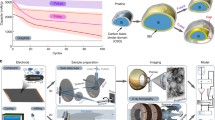Abstract
Mechanical degradation of electrode materials, in the form of particle cracking and fragmentation, disintegration, fracturing, and loss in contact between current collectors and the active electrode materials, can affect or deteriorate the performance of Li-ion batteries dramatically and even lead to the battery failure in electric vehicle. This paper firstly built a single particle model (SPM) based upon kinetics of electrochemical reactions. Then the Li-ion concentration, evolution of diffusion induced stresses within the SPM under potentiostatic or galvanostatic operating conditions were analyzed by utilizing a mathematical method. Next, evolution of stresses or strains in the SPM, at the core of relates with mechanical degradation of electrode materials, are elaborated in detail. Finally, surface and morphology of the electrodes dismantled from fresh and degraded cells after galvanostatic charge/discharge cycling have been analyzed to verify the hypothesis aforementioned by observing scanning electron microscopy and analyzing X-ray diffraction.





Similar content being viewed by others
References
C. Wang, H. He, Y. Zhang, H. Mu, A comparative study on the applicability of ultracapacitor models for electric vehicles under different temperatures. Appl. Energy 196, 268–278 (2017)
F. Sun, R. Xiong, A novel dual-scale cell state-of-charge of estimate approach for series-connected battery pack used in electric vehicles. J. Power Sources 274, 582–594 (2015)
F. Sun, R. Xiong, H. He, A systematic state-of-charge of estimate framework for multi-cell battery pack in electric vehicles using bias correction technique. Appl. Energy 162, 1399–1409 (2016)
Y.-T. Cheng, M.W. Verbrugge, Evolution of stress within a spherical insertion electrode particle under potentiostatic and galvanostatic operation. J. Power Sources 190, 453–460 (2009)
B. Stiaszny, J.C. Ziegler, E.E. Krauß, M. Zhang, J.P. Schmidt, E. Ivers-Tiffée, Electrochemical characterization and post-mortem analysis of aged \(\text{ LiMn }_{2}\text{ O }_{4}\)–NMC/graphite lithium ion batteries part II: calendar aging. J. Power Sources 258, 61–75 (2014)
J. Christensen, J. Newman, Stress generation and fracture in lithium insertion materials. J. Solid State Electrochem. 10, 293–319 (2006)
M. Doyle, T.F. Fuller, J. Newman, Modeling of galvanostatic charge and discharge of the lithium/polymer/insertion cell. J. Electrochem. Soc. 140(6), 1526–1533 (1993)
R. Deshpande, Y.-T. Cheng, M.W. Verbrugge, Modeling diffusion-induced stress in nanowire electrode structures. J. Power Sources 195, 5081–5088 (2010)
R. Deshpande, Y. Qi, Y.-T. Cheng, Effects of concentration-dependent elastic modulus on diffusion-induced stresses for battery applications. J. Electrochem. Soc. 157(8), A967–A971 (2010)
R. Deshpande, Y.-T. Cheng, M.W. Verbrugge, A. Timmons, Diffusion induced stresses and strain energy in a phase transforming spherical electrode particle. J. Electrochem Soc. 158, A718–A724 (2011)
R.A. Huggins, W.D. Nix, Decrepitation model for capacity loss during cycling of alloys in rechargeable electrochemical systems. Ionics 6, 57–63 (2000)
K.E. Aifantis, J.P. Dempsey, Stable crack growth in nanostructured Li-batteries. J. Power Sources 143(1), 203–211 (2005)
M. Ebner, F. Marone, M. Stampanoni, V. Wood, Visualization and quantification of electrochemical and mechanical degradation in Li ion batteries. Science 342, 716–719 (2015)
F. Wu, N. Li, Y.F. Su, H.F. Shou, L.Y. Bao et al., Spinel/layered heterostructured cathode material for high-capacity and high-rate Li-ion batteries. Adv. Mater. 25, 3722–3726 (2013)
S.J. Harris, R. Deshpande, Y. Qi, I. Dutta, Y.-T. Cheng, Mesopores inside electrode particles can change the Li-ion transport mechanism and diffusion-induced stress. J. Mater. Res. 25, 1433–1440 (2010)
W.H. Woodford, Y.-M. Chiang, W.C. Carter, “Electrochemical shock” of intercalation electrodes: a fracture mechanics analysis. J. Electrochem. Soc. 157, A1052–A1059 (2010)
L. Chen, Y. Su, S. Chen, N. Li, L. Bao et al., Hierarchical \(\text{ Li }_{1.2}\) \(\text{ Ni }_{0.2}\) \(\text{ Mn }_{ 0.6}\) \(\text{ O }_{2}\) nanoplates with exposed 010 planes as high-performance cathode material for lithium-ion batteries. Adv. Mater. 26, 6756–6760 (2014)
R.T. Purkayastha, R.M. McMeeking, An integrated 2-D model of a lithium ion battery: the effect of material parameters and morphology on storage particle stress. Comput. Mech. 50, 209–227 (2012)
F. Wu, N. Li, Y. Su, L. Zhang, L. Bao, Ultrathin spinel membrane-encapsulated layered lithium-rich cathode material for advanced li-ion batteries. Nano Lett. 14, A366–A380 (2014)
Y.-T. Cheng, M.W. Verbrugge, Diffusion-induced stress, interfacial charge transfer, and criteria for avoiding crack initiation of electrode particles. J. Electrochem. Soc. 157, A508–A516 (2010)
Y.-T. Cheng, M.W. Verbrugge, Application of Hasselman’s crack propagation model to insertion electrodes. Electrochem. Solid State Lett. 13, A128–A131 (2010)
B.S. Haran, B.N. Popov, R.E. White, Determination of the hydrogen diffusion coefficient in metal hydrides by impedance spectroscopy. J. Power Sources 75, 56–63 (1998)
E. Tatsukawa, K. Tamura, Activity correction on electrochemical reaction and diffusion in lithium intercalation electrodes for discharge/charge simulation by single particle model. Electrochim. Acta. 115, 75–85 (2014)
W. Fang, O.J. Kwon, C.-Y. Wang, Electrochemical-thermal modeling of automotive Li-ion batteries and experimental validation using a three-electrode cell. Int. J. Energy Res. 34, 107–115 (2010)
A.P. Schmidt, M. Bitzer, Á.W. Imre, L. Guzzella, Experiment-driven electrochemical modeling and systematic parameterization for a lithium-ion battery cell. J. Power Sources 195, 5071–5080 (2010)
K.A. Smith, C.D. Rahn, C.-Y. Wang, Model-based electrochemical estimation and constraint management for pulse operation of lithium ion batteries. IEEE Trans. Control Syst. Technol. 18, 654–663 (2010)
Y. Qi, H. Guo, L.G. Hector Jr., A. Timmons, Threefold increase in the Young’s modulus of graphite negative electrode during lithium intercalation. J. Electrochem. Soc. 157(5), A558–A566 (2010)
S.P. Timoshenko, J.N. Goodier, Theory of Elasticity, 3rd edn. (McGraw-Hill, New York, 1970)
J. Crank, The Mathematics of Diffusion, 2nd edn. (Clarendon, Oxford, 1956)
A.V. Shobukhov, D.S. Maximov, Exact steady state solutions in symmetrical Nernst–Planck–Poisson electrodiffusive models. J. Math. Chem. 52, 1338–1349 (2014)
Acknowledgements
This work was supported by the Sichuan Provincial Department of Education (17ZB0305); Zigong Key Science and Technology Project (2016HG07); Sichuan Provincial Key Lab of Process Equipment and Control Foundation (GK201603); and the Sichuan Application Foundation Projects (Grant No. 2016JY0098).
Author information
Authors and Affiliations
Corresponding author
Rights and permissions
About this article
Cite this article
Tang, A., Hu, G. & Liu, M. Mechanical degradation of electrode materials within single particle model in Li-ion batteries for electric vehicles. J Math Chem 55, 1903–1915 (2017). https://doi.org/10.1007/s10910-017-0770-8
Received:
Accepted:
Published:
Issue Date:
DOI: https://doi.org/10.1007/s10910-017-0770-8




